|
 Mycena austrororida Mycena austrororida
SynonymsMycena veronicae
Agaricus stellatus
Omphalia stellata
BiostatusPresent in region - Indigenous. Non endemic
Images (click to enlarge)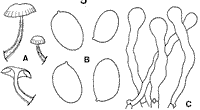
Caption: Mycena austrororida Singer (ZT 66/349): A. carpophores. - B. spores. - C. cheilocystidia | 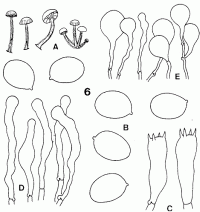
Caption: Mycena austrororida Singer (.ZT 68/390): A. carpophores. - B. spares. - C. basidia. - D. cheilocystidia. - E. cuticle | 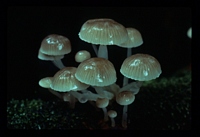
Owner: Herb. PDD | 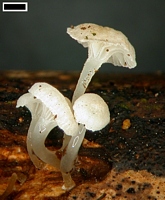
Caption: scale=1mm
Owner: J.A. Cooper | 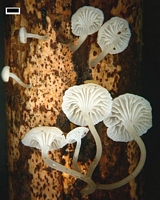
Caption: scale=1mm
Owner: J.A. Cooper | 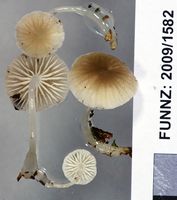
Owner: J.A. Cooper | 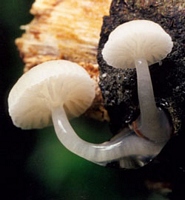
Caption: Mycena austrororida
Owner: Kaimai Bush | 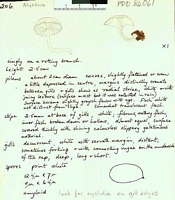
Caption: Watercolour
Owner: G.M. Taylor | 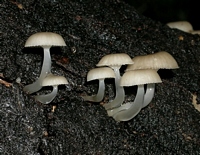
Owner: J.A. Cooper | 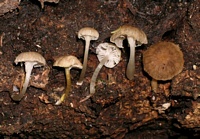
Owner: J.A. Cooper | 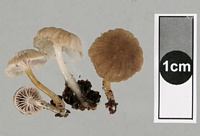
Owner: J.A. Cooper | 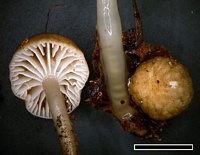
Caption: scale=5mm
Owner: J.A. Cooper | 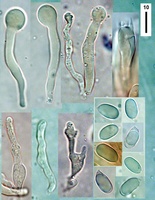
Caption: two kinds of cheilocystidia, basidium and spores
Owner: J.A. Cooper | 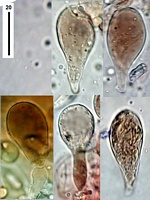
Caption: cap cells.
Owner: J.A. Cooper | 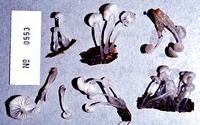
Caption: ZT0553
Owner: E. Horak: © Creative Commons Attribution-Noncommercial 3.0 New Zealand | 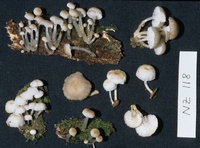
Caption: ZT9384, NZ-118
Owner: E. Horak: © Creative Commons Attribution-Noncommercial 3.0 New Zealand | 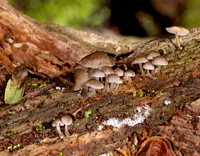
Owner: J.A. Cooper | 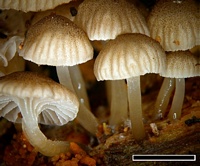
Caption: scale=5mm
Owner: J.A. Cooper | 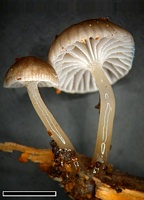
Caption: scale=5mm
Owner: J.A. Cooper | 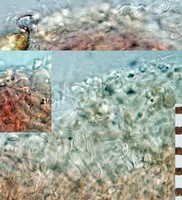
Caption: section through cap surface (melzers)
Owner: J.A. Cooper | 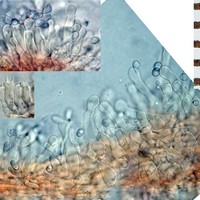
Caption: cheilocystidia
Owner: J.A. Cooper | 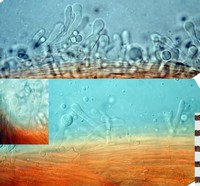
Caption: caulocystidia
Owner: J.A. Cooper | 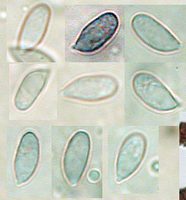
Owner: J.A. Cooper | 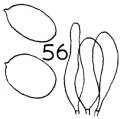 | 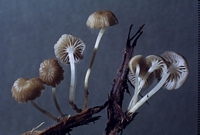
Owner: Herb. PDD | 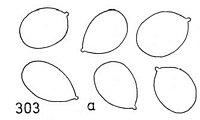
Caption: 303-Mycena veronicae [Omphalia stellata]: a. spores. |
Article: Horak, E. (1978). Mycena rorida (Fr.) Quel. and related Species from the Southern Hemisphere. Berichte der Schweizerischen Botanischen Gesellschaft 88(1/2): 20-29.
Description: Pileus -20 mm, hemispherical or convex when
young later becoming either depressed or subumbonate at centre, not distinctly
umbonate, striate margin incurved, white, pale brownish, pale grey-brown or
pale yellow-brown, centre covered with minute brown or black dots or squamules,
membranaceous, dry. Lamellae (L6-l4, 1-3), arcuate-decurrent, white to pallid,
edge albofimbriate, occasionally with subglutinous detachable thread. Stipe
-50 / -2 mm, cylindric or slightly attenuated towards apex, white or pale grey-brown,
glutinous when wet, pruinose in dry condition, hollow, single or in dense clusters.
Odour and taste pot distinctive. Context pale brown beneath cuticle, white in
stipe. Chemical reactions on pileus: KOH-negative.
Spores 9-12 (12,5) / 6-8 µm., ovate to broadly
elliptic, hyaline, smooth, amyloid. Basidia 28-40 / 9-13 µm, 4-spored. Cheilocystidia
40-80 / 3-9 µm., cylindric-subclavate to elongate-clavate, rarely elongate-fusoid,
hyaline, thin-walled membrane. Caulocystidia similar. Cuticle a celluloderm
of clavate cells (20-90 / 10-30 µm.), with brown plasmatic pigment. Clamp connections
present.
Habitat: On rotting leaves, bark and wood of trees (in
New Zealand observed on Pinus. Leptospermum, Rhipogonum), rarely on herbaceous
debris. Juan Fernandez (type), Chile, Argentina (Singer 1969: 1 19), New Zealand.
Notes: According to Singer (1969: 119) the type material
of M. austrororida is kept in S. However, despite intensive search, the
type collection was not located there.
Based upon our present knowledge M. austrororida
is distributed in the sub-antartic region East (Juan Fernandez, southern parts
of Chile and Argentina) and West (New Zealand) of the Pacific Ocean. Careful
macroscopical and microscopical observations showed that there are no distinctive
differences between the specimens cited above (compare also Fig. 5 and 6), with
one exception: the cheilocystidia of the South American collections are more
clavate-subcapitate as the ones observed on New Zealand specimens. Concerning
luminescence of the carpophores no information has been reported yet.
Article: Stevenson, G. (1964). The Agaricales of New Zealand: V. Kew Bulletin 19(1): 1-59.
Description: Pileus 3-15 mm diam., pale olive fawn to whitish with fawn tint, hemispheric to plano-convex, becoming indistinctly sulcate-striate at margin smooth to velvety; flesh thin, fawn. Gills strongly decurrent, white with minutely fringed margins, moderately distant, with long and short intercalated. Stipe 1-2 cm. x 1-3 mm, white to pale fawn, glutinous, hollow-fragile, with or without a few spreading hairs at swollen base. Spores 10-11 x 6-8 µm, amyloid, thin-walled. Hymenophoral trama and tissue of pileus pseudoamyloid. Cheilocystidia hair-like to ovate, 20-30 x 5-10 µm. Cuticle with scattered swollen dermatocystidia, 20-35 x l5-20 µm, with grey contents (Fig. 56).
Habitat: On fallen wood, Karori, Wellington, 12.6.1949, Stevenson; Silverstream, 21.4.1958, Helen Druce, Kelburn, 20.5.1958, Veronica Fell in Stevenson (type); Keith George Park, 7.6.1958, Stevenson.
Article: Massee, G.E. (1899) [1898]. The fungus flora of New Zealand. Transactions and Proceedings of the New Zealand Institute 31: 282–349 Wellington:.
Description: Entirely white. Pileus truly membranaceous, convex, umbilicate, pellucidly striate, glabrous,
1-1.5 cm. across; gills decurrent, rather distant, thin, not triangular; spores elliptical, 6-7 X 4
µ; stem usually about 2 cm. long, very slender, fragile, stuffed, then hollow, often curved,
base dilated and radially strigose or hairy.
Habitat: On logs, stumps, &c.
Distribution: Dannevirke, New Zealand. Europe.
Notes: Often gregarious. Distinguished by the semitranslucent white colour of every part, and the
strigose base of the stem. Pileus frequently excentric.
Article: Horak, E. (1971). A contribution towards the revision of the Agaricales (Fungi) from New Zealand. New Zealand Journal of Botany 9(3): 403-462 (http://www.rsnz.org/publish/abstracts.php).
Notes: Omphalia stellata (Fries) (8,16) Fig. 25 = Mycena veronicae Stevenson
The identification of this material (COLENSO 545 b) is confirmed by the typical
club-shaped cells in the cuticle filled with a brown cell sap, decurrent gills, and
the ovoid spores.
|